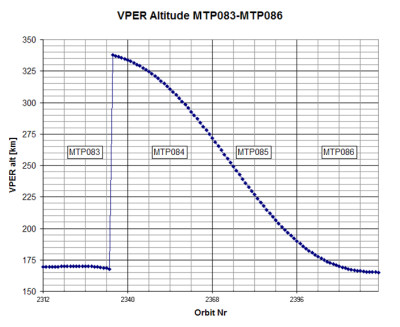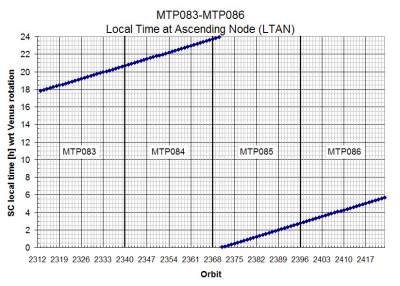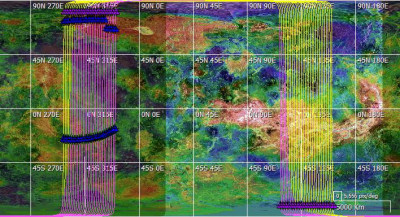No. 251 - Continuation of the thirteenth Earth occultation season; high-accuracy spacecraft ranging with new ESA ground station; end of the ninth Atmospheric Drag Experiment campaign and quadrature operations
Cebreros ground station
Most Cebreros ground station activities were nominal. In preparation for end of quadrature operations, the spacecraft's High Gain Antenna-2 (HGA-2) was swapped on 20 August, switching the primary (HGA-1) into use. The swap was executed flawlessly and the telemetry bit rate was restored to its maximum value of 228 kbps.
Due to a short drop on a Cebreros telemetry line on 24 August, some science data acquired by the Venus Monitoring Camera (VMC) and the Visible and Infrared Thermal Imaging Spectrometer (VIRTIS) were lost temporarily. These data were later recovered.
Two orbit correction manoeuvres were executed on 9 and 10 September (see below). To allow for cooling between the manoeuvres, the spacecraft skipped a ground station pass with Cebreros on 10 September.
Scheduled nominal maintenance activities with Cebreros were carried out on 11 and 12 September; to accommodate these the ground station passes were shortened on these dates.
New Norcia ground station
Most New Norcia (NNO) ground station activities were nominal. The ground station did not record occultation observations performed on 25 August. An investigation into this incident is ongoing. Earlier (on 22 August) and later (28 and 31 August) occultation observations were successful.
High accuracy spacecraft ranging
ESA's new ground station at Malargüe and the Cebreros ground station were used for a Delta Differential One-way Ranging (delta-DOR, or DDOR) measurement on 21 August. These measurements are carried out with the Venus Express spacecraft on a regular basis to support the accurate determination of the ephemeris for the planet Venus that is maintained by NASA's Solar System Dynamics Group.
For more information about DDOR, see the "Delta-DOR measurements" link in the right-hand menu.
End of the ninth Atmospheric Drag Experiment campaign
The ninth Atmospheric Drag Experiment (ADE) campaign started with pre-ADE torque experiments beginning on 17 August. Nine ADE measurements were carried out from 26 August to 7 September, and the campaign ended with an orbit correction manoeuvre on 9 September.
The lowest pericentre height during this ADE was 170 kilometres.
 |
|
Change in Venus Express pericentre altitude during the period from 19 August to 8 December 2012. Credit: ESA |
ADE and quadrature operations (see link in right-hand menu) are normally two independent operations. However, for the period between July and September 2012, both coincided and hence influenced each other in terms of scheduling, safety and science planning. The outbound quadrature phase started on 7 August 2012 and ended on 11 September 2012, concurrent with part of the ADE campaign. The outbound quadrature contained the operationally mandatory swap from HGA-2 to HGA-1 due to the change of the Sun-spacecraft-Earth angle which would otherwise violate the thermal constraints.
In addition, this ADE campaign was coincident with an Earth occultation season, when the pericentre periods are used for radio science observations that probe the Venusian atmosphere. This was the first time that a situation occurred where the spacecraft was operation during quadrature while also doing both ADE and Earth occultation observations. It was decided that no tracking would be performed by ground stations during the pericentre crossings. Therefore, this ADE campaign only recorded the torque experiment data, and did not record the Doppler data at the ground stations.
For more information on ADE campaigns, see the link in the right-hand menu.
Orbit correction manoeuvres
Two orbit correction manoeuvres (OCM) were carried out to re-phase the spacecraft orbit and raise the altitude of the spacecraft at the end of the ninth ADE campaign. These were executed on 9 and 11 September, at the pericentre and apocentre respectively. The Cebreros ground station pass on 10 September was skipped so as to allow the spacecraft to cool between manoeuvres.
The Flight Operations Team noted that the spacecraft thrusters underperformed slightly on 10 September. The overall effect of both OCMs was only marginally different from the desired impact on the spacecraft orbit, with the resulting change in the orbit timing for the two burns being within two tenths of a second of the planned change. Upon analysis, the team found the thruster anomaly to be temporary; the thruster recovered after the incident.
End of quadrature operations
From 7 August, Venus Express has been operating in the outbound quadrature configuration. In preparation for the end of quadrature that occurred on 11 September, the smaller antenna (HGA-2) that was in use was swapped on 20 August, switching back to the primary antenna (HGA-1). This brought the telemetry bit rate back to its maximum nominal of 228 kbps. The fake ephemeris (10 degrees bias of the spacecraft attitude), necessary to protect thermally sensitive faces of the spacecraft and some of the instruments, was also removed.
For more information about Venus Express operations during quadrature, see the link in the right-hand menu.
Continuation of the thirteenth occultation season
The mission's longest Earth occultation season continued during this period; science observations were carried out in eight orbits from 22 August to 12 September using the SPICAV (Spectroscopy for Investigation of Characteristics of the Atmosphere of Venus) instrument, and its Solar Occultation at Infrared (SOIR) channel. The occultations occurred before pericentre, in the ascending branch of the orbit and the science observations were often made immediately before and in conjunction with the ADE observations.
See 'Venus Express Earth occultation seasons' (in right-hand menu) for further information about the science observations that are performed during these seasons.
Summary of main activities
The table below shows a chronology of the main spacecraft bus activities in the reporting period:
| Main activities during reporting period | |||
|
ADE = Atmospheric Drag Experiment; CEB = Cebreros; DOR = Differential One-way Ranging; DOY = Day of year; HGA = High Gain Antenna; MET = Mission elapsed time; NNO = New Norcia; OCM = Orbit Correction Manoeuvre; TM = telemetry |
|||
|
MET (Day) |
Date | DOY | Main Activity |
| 2476 | 19-Aug-12 | 232 | Torque experiment at pericenter as part of ADE #9 activities. CEB communication pass |
| 2477 | 20-Aug-12 | 233 | Swap to HGA-1. TM bit rate changed to 228kbps. CEB communication pass |
| 2478 | 21-Aug-12 | 234 | Torque experiment at pericenter as part of ADE #9 activities. CEB communication pass. Delta-DOR performed with Malargüe and CEB support |
| 2479 | 22-Aug-12 | 235 | NNO occultation. CEB communication pass. |
| 2480 | 23-Aug-12 | 236 | Ground station pass skipped |
| 2481 | 24-Aug-12 | 237 | Torque experiment at pericentre as part of ADE #9 activities. CEB communication pass. Short drop on CEB telemetry line followed by temporary loss of VIRTIS and VMC data, later recovered |
| 2482 | 25-Aug-12 | 238 | NNO occultation (observation not recorded). CEB communication pass |
| 2483 | 26-Aug-12 | 239 | CEB communication pass. ADE #9 with solar array tilt |
| 2484 | 27-Aug-12 | 240 | CEB communication pass. ADE #9 with solar array tilt |
| 2485 | 28-Aug-12 | 241 | CEB communication pass. Observations for occultation season #13 performed using NNO |
| 2486 | 29-Aug-12 | 242 | CEB communication pass. ADE #9 with solar array tilt |
| 2487 | 30-Aug-12 | 243 | CEB communication pass. ADE #9 with solar array tilt |
| 2488 | 31-Aug-12 | 244 | CEB communication pass. Observations for occultation season #13 performed using NNO |
| 2489 | 01-Sep-12 | 245 | CEB communication pass. ADE #9 with solar array tilt |
| 2490 | 02-Sep-12 | 246 | CEB communication pass. Observations for occultation season #13 performed using NNO |
| 2491 | 03-Sep-12 | 247 | Ground station pass skipped |
| 2492 | 04-Sep-12 | 248 | CEB communication pass. Observations for occultation season #13 performed using NNO |
| 2493 | 05-Sep-12 | 249 | Ground station pass skipped |
| 2494 | 06-Sep-12 | 250 | CEB communication pass. Observations for occultation season #13 performed using NNO |
| 2495 | 07-Sep-12 | 251 | CEB communication pass. ADE #9 with solar array tilt |
| 2496 | 08-Sep-12 | 252 | CEB communication pass. Observations for occultation season #13 performed using NNO |
| 2497 | 09-Sep-12 | 253 | CEB communication pass. OCM at pericentre |
| 2498 | 10-Sep-12 | 254 | Ground station pass skipped. OCM at apocentre |
| 2499 | 11-Sep-12 | 255 | CEB communication pass. Pass shortened due to maintenance at CEB. End of quadrature |
| 2500 | 12-Sep-12 | 256 | NNO Occultation. CEB communication pass. Pass shortened due to maintenance at CEB |
| 2501 | 13-Sep-12 | 257 | CEB communication pass |
| 2502 | 14-Sep-12 | 258 | CEB communication pass |
| 2503 | 15-Sep-12 | 259 | CEB communication pass |
At the end of the reporting period on 15 September, Venus Express was 141.7 million kilometres from Earth. The one-way signal travel time was 472 seconds. The final oxidizer mass was 23.847 kg and the final fuel mass was 14.742 kg.
Scientific focus
This reporting period falls under medium term plan (MTP) #83, which covers the period 18 August to 15 September 2012.
A long Earth occultation season, the mission's longest, continued throughout this period. In addition, operations started off in quadrature illumination conditions, which lasted until 11 September, ruling out hot observations unless a communications pass was skipped.
Local time at ascending node (LTAN) changed from 17:40 to 20:40, thus the period was 'hot' for the first few orbits until the terminator orbit (22 August 2012), after which it was a 'cold' season.
 |
|
Venus Express LTAN (19 August to 8 December 2012). Credit: ESA |
The data rate was very low for the first two orbits of this period, but became extremely high after 20 August when the high gain antenna swap – exchanging the small antenna (HGA-2) with the big antenna (HGA-1) – took place. The downlink data rate was 28.566 bits/s before the swap, rising to 228.531 bits/s after the swap – this is the maximum rate.
Atmospheric Drag Experiment campaign #9 (torque measurements only; no doppler measurements) continued until 1 September. Two orbit correction manoeuvres were subsequently carried out.
The combination of an Earth occultation season and a drag season meant alternating between Venus Radio Science Experiment (VeRa) custom pointings and Atmospheric Drag Experiment (ADE) observations at pericentre.
 |
|
Venus Express coverage of Venus (19 August to 15 September 2012). Credit: ESA |
The Venus Express spacecraft flew along the terminator, the dividing line between the day and night sides of the planet, on 21-22 August 2012.
Payload activities
| ASPERA | The instrument was regularly operated nominally as part of the routine plan. |
| MAG | The instrument was regularly operated nominally as part of the routine plan. |
| PFS | The instrument was not operated. |
| SPICAV | The instrument was regularly operated nominally as part of the routine plan. |
| VMC |
The instrument was regularly operated nominally as part of the routine plan.
A short drop on the Cebreros telemetry line on 24 August resulted in the temporary loss of science data. These data were later recovered. |
| VeRa |
The instrument was regularly operated nominally as part of the routine plan.
The instrument was operated for occultation passes with the New Norcia ground station. |
| VIRTIS |
The instrument was regularly operated nominally as part of the routine plan.
A short drop on the Cebreros telemetry line on 24 August resulted in the temporary loss of science data. These data were later recovered. |
Future milestones
- Prepare power system for eclipse season
- Start of the twenty-second eclipse season
- Start of the tenth ADE campaign
- End of the thirteenth occultation season
---
Legal disclaimer
This report is based on four ESOC mission operations reports, MOR #352 through MOR #355, as well as the MTP83 Master Science Plan. Please see the copyright section of the legal disclaimer (bottom of this page) for terms of use.

